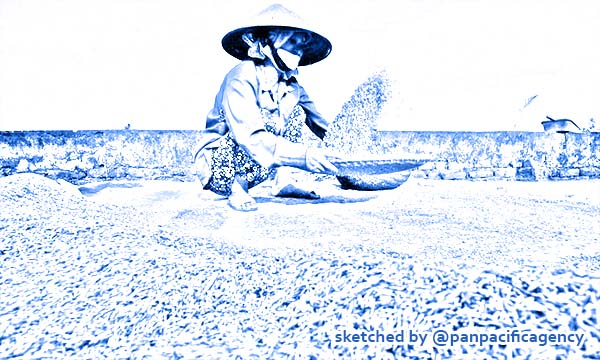Vietnam aims to have all districts, communes recognized as new rural areas by 2030

A farmer harvests rice by a paddy field outside Hanoi. Photo by Reuters/Kham. Sketched by the Pan Pacific Agency.
HANOI, Sep 18, 2019, VNA. Hanoi has achieved many targets regarding agricultural development and building new-style rural areas after 10 years implementing the National Target Programme on Building New-Style Rural Areas and the municipal Party Committee’s Programme 02-Ctr/TU, reported the Vietnam News Agency.
The city so far has six districts recognized as meeting all criteria for new-style rural areas, which are Dan Phuong, Dong Anh, Thanh Tri, Hoai Duc, Gia Lam and Quoc Oai. At the same time, 325 out of 386 communes of the city, or 84.2 percent, also earned the title. The rate is much higher than the national average of 50.8 percent. All the remaining communes have also met at least 10 criteria.
As such the city has fuflfilled the target on new-style rural areas set by Programme 02-Ctr/TU two years ahead of schedule.
At the same time, the agricultural, forestry and fishery sector recorded an average growth of 3.34 percent a year in the 2010-2018 period. Total agricultural production value reached 259 million VND per hectare per year in 2018, fulfilling the target of 250 million VND set by Programme 02-Ctr/TU two years ahead of schedule. The figure was up 117 million VND per ha per year compared to 2010.
Hanoi has pinpointed land accumulation as the main breakthrough in agricultural development toward commercial farming, creating large material growing zones, thus facilitating the building of new-style rural areas. The city has merged nearly 80,000 ha of farming fields.
An important criterion for new-style rural areas is new production models. The city has seen the introduction of 133 hi-tech agricultural production models and 135 safe food chains from production to sales, which have proven effective in enhancing economic value of agricultural products.
Along with the development of agricultural production and new-style rural areas, the living conditions of rural residents have constantly improved over the past years. Per capita income in Hanoi’s rural areas currently stood at 46.5 million VND a year, an increase of 33.5 million VND from the level in 2010. The rate of poverty among rural households has dropped to 1.81 percent, and even under 1 percent in some districts, such as Quoc Oai (0.46 percent), Gia Lam (0.56 percent) and Hoai Duc (0.92 percent). The systems of medical facilities, schools and cultural establishments have been improved over the years, contributing to enhancing the living conditions in rural areas.
According to Nguyen Van Chi, standing deputy chief of the city office for new-style rural areas, the municipal Party Committee has organized 55 inspections and working sessions with localities and relevant agencies in order to timely tackle difficulties and obstacles arising in the process of building new-style rural areas.
The municipal People’s Council has issued 14 resolutions on the work, and approved increasing budget allocation for the development of agriculture and rural areas and farmers.
“Besides support from the State budget, Hanoi has successfully mobilized capital from organisations, enterprises, households and individuals for the new-style rural area building programme. Such contribution amounted to 14.7 trillion VND, or 19.3 percent of the total investment in the programme,” Chi said. He added that urban districts also provided aid worth 633 billion VND to poor rural districts.
Hanoi has set the target to have 100 percent of rural districts and communes recognized as new-style rural areas by 2030, with at least 5 districts and half of the rural communes meeting criteria for model rural areas.
The city also aims for an annual growth of 3 – 3.5 percent in agricultural production, and a per capita income of at least 75 million VND a year for rural residents.
The National Target Programme on New-style Rural Development was launched in 2010. It sets 19 criteria for new-style rural areas covering infrastructure, production, living standards, income, culture and others.